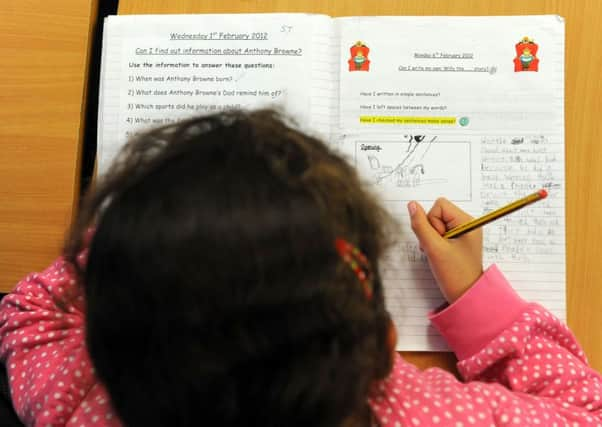YP Comment: Primary lesson over school test. Learning the basics at the outset


Yet the fact that almost 40 per cent of children did not meet the Government’s benchmark, according to the Department for Education’s latest performance data, justifies the approach of Ministers in spite of the misgivings expressed by Ms Wood and the teaching unions.
For, while it would be churlish not to acknowledge the significant improvement that has taken place in the past year, it still means that nearly four out of 10 pupils are completing their primary education with a poor grasp of those key skills which are critical to future academic success.
Advertisement
Hide AdAdvertisement
Hide AdSome will make this lost ground up – no system of tests can adequately reflect the fact that children learn at different rates and the impact of other factors, like the quality of teaching and home environment, should also be acknowledged.
Nevertheless, a significant number of youngsters will struggle at secondary school because they don’t have a good grasp of the basics. Successive governments are to blame for ignoring the concerns of primary schools about class sizes and inadequate support being available for those pupils who do need one-to-one mentoring and encouragement.
As such, the renewed promise that no school will have its existing funding cut is important. However Ministers needs to realise that this issue is just as important as the quality of GCSE and A-Level passes accrued by teenagers. As Brexit adds some impetus to the skills debate, the equation is a simple one. If more youngsters learn the basics at the outset, the greater the likelihood that they will succeed later on. It’s not rocket science.
Firm foundations
EVEN though the perception is that rural residents are instinctively opposed to new developments so their views remain unspoilt, most appreciate that countryside communities need to evolve if they’re to survive. The challenge is making sure that any new schemes are in keeping with an area’s character, hence today’s report by the Country Land and Business Association which has investigated the issue in depth. Its findings need to be taken on board.
Advertisement
Hide AdAdvertisement
Hide AdFor, while it’s been long established that there is a nationwide housing shortage and young families are being priced out of rural areas because supply has not kept pace with demand, there are landowners, farmers and businesses who are reluctant to advance schemes because planning bodies have been allowed to become too pernickety in their humble opinion.
A balance needs to be struck. Though it is reassuring that there remain officials who appreciate the importance of the countryside’s aesthetic appeal, CLA president Ross Murray notes that incremental increases in the number of smaller pockets of land becoming available would ease pressure on those villages and towns earmarked for larger developments which might, in turn, become too over-bearing for their own good.
With nearly two-thirds of surveyed landowners saying they would build new homes to rent or buy if they had more confidence in their local planning department, a slightly revised approach could provide firmer foundations for the future. Then, the challenge is making sure a greater proportion of these properties are affordable to first-time buyers – and those families – who yearn to live in the countryside and support the rural economy.
A shop window
IN just three years, the Tour de Yorkshire has grown in stature and is now established on the professional cycling map. Just as significant as the purported number of spectators – an estimated 2.2 million – is the reported increase in the number of international broadcasters now covering the race.
Advertisement
Hide AdAdvertisement
Hide AdNot only is this indicative of cycling’s popularity, but this is Yorkshire’s ‘shop window’ to the world – it means iconic images of this county’s stunning scenery are being shown to a global audience that continues to grow in size. This awareness can only help attract more tourists here.
And unlike the Olympic Games and Commonwealth Games which are held every four years, and move from city to city, this annual race – and the UCI Road World Championships in two years time – means Yorkshire will continue to benefit from its yellow jersey position at the head of cycling’s peloton.